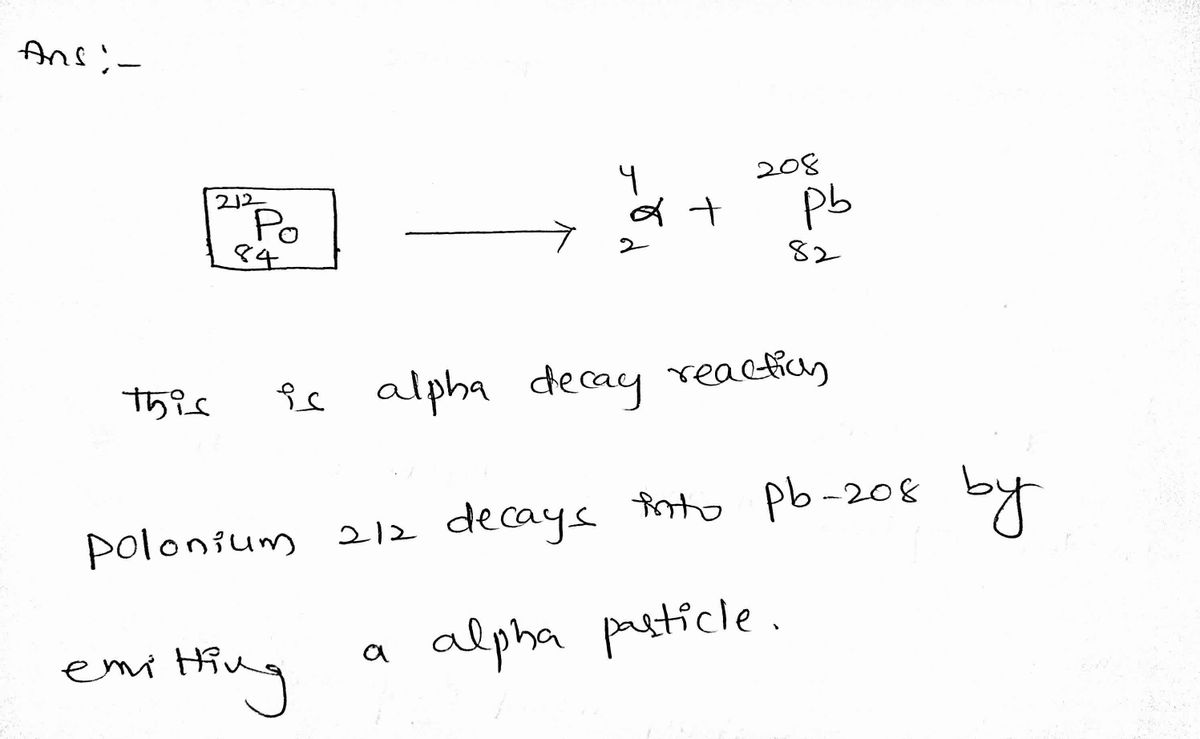Chemistry
10th Edition
ISBN:9781305957404
Author:Steven S. Zumdahl, Susan A. Zumdahl, Donald J. DeCoste
Publisher:Steven S. Zumdahl, Susan A. Zumdahl, Donald J. DeCoste
Chapter1: Chemical Foundations
Section: Chapter Questions
Problem 1RQ: Define and explain the differences between the following terms. a. law and theory b. theory and...
Related questions
Question
What element should go in the empty box in this equation
![**Multiple Choice Question:**
"What element should go in the empty box in this equation?" *(10 points)*
\[ \text{ } \square \rightarrow \, {^4_2 \alpha} + \, {^{208}_{82} \text{Pb}} \]
**Explanation:**
The equation represents a nuclear reaction where an unknown element decays by emitting an alpha particle (\( \alpha = {^4_2 \text{He}} \)) to produce lead-208 (\( \text{Pb} \)).
To determine the missing element:
1. **Atomic Number:**
The atomic number must add up on both sides of the equation. Since the alpha particle has an atomic number of 2 and lead (Pb) has an atomic number of 82, the unknown element must have an atomic number of \( 82 + 2 = 84 \).
2. **Mass Number:**
The mass number must also balance. The alpha particle has a mass number of 4 and lead (Pb) has a mass number of 208. Therefore, the unknown element must have a mass number of \( 208 + 4 = 212 \).
The element with atomic number 84 is Polonium (Po), so the unknown element is Polonium-212 (\( ^{212}_{84} \text{Po} \)).](/v2/_next/image?url=https%3A%2F%2Fcontent.bartleby.com%2Fqna-images%2Fquestion%2F24bf2450-39e8-47a2-b6d3-2df49a54adbe%2F46599706-8bf7-4f3c-94a6-88b606111642%2Favu48v_processed.jpeg&w=3840&q=75)
Transcribed Image Text:**Multiple Choice Question:**
"What element should go in the empty box in this equation?" *(10 points)*
\[ \text{ } \square \rightarrow \, {^4_2 \alpha} + \, {^{208}_{82} \text{Pb}} \]
**Explanation:**
The equation represents a nuclear reaction where an unknown element decays by emitting an alpha particle (\( \alpha = {^4_2 \text{He}} \)) to produce lead-208 (\( \text{Pb} \)).
To determine the missing element:
1. **Atomic Number:**
The atomic number must add up on both sides of the equation. Since the alpha particle has an atomic number of 2 and lead (Pb) has an atomic number of 82, the unknown element must have an atomic number of \( 82 + 2 = 84 \).
2. **Mass Number:**
The mass number must also balance. The alpha particle has a mass number of 4 and lead (Pb) has a mass number of 208. Therefore, the unknown element must have a mass number of \( 208 + 4 = 212 \).
The element with atomic number 84 is Polonium (Po), so the unknown element is Polonium-212 (\( ^{212}_{84} \text{Po} \)).
Expert Solution
Step 1

Step by step
Solved in 2 steps with 2 images

Recommended textbooks for you

Chemistry
Chemistry
ISBN:
9781305957404
Author:
Steven S. Zumdahl, Susan A. Zumdahl, Donald J. DeCoste
Publisher:
Cengage Learning

Chemistry
Chemistry
ISBN:
9781259911156
Author:
Raymond Chang Dr., Jason Overby Professor
Publisher:
McGraw-Hill Education

Principles of Instrumental Analysis
Chemistry
ISBN:
9781305577213
Author:
Douglas A. Skoog, F. James Holler, Stanley R. Crouch
Publisher:
Cengage Learning

Chemistry
Chemistry
ISBN:
9781305957404
Author:
Steven S. Zumdahl, Susan A. Zumdahl, Donald J. DeCoste
Publisher:
Cengage Learning

Chemistry
Chemistry
ISBN:
9781259911156
Author:
Raymond Chang Dr., Jason Overby Professor
Publisher:
McGraw-Hill Education

Principles of Instrumental Analysis
Chemistry
ISBN:
9781305577213
Author:
Douglas A. Skoog, F. James Holler, Stanley R. Crouch
Publisher:
Cengage Learning

Organic Chemistry
Chemistry
ISBN:
9780078021558
Author:
Janice Gorzynski Smith Dr.
Publisher:
McGraw-Hill Education

Chemistry: Principles and Reactions
Chemistry
ISBN:
9781305079373
Author:
William L. Masterton, Cecile N. Hurley
Publisher:
Cengage Learning

Elementary Principles of Chemical Processes, Bind…
Chemistry
ISBN:
9781118431221
Author:
Richard M. Felder, Ronald W. Rousseau, Lisa G. Bullard
Publisher:
WILEY